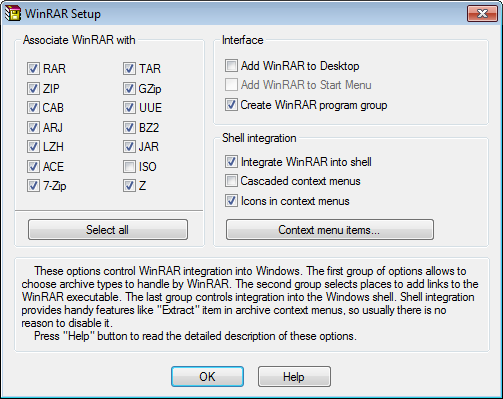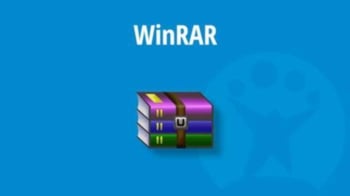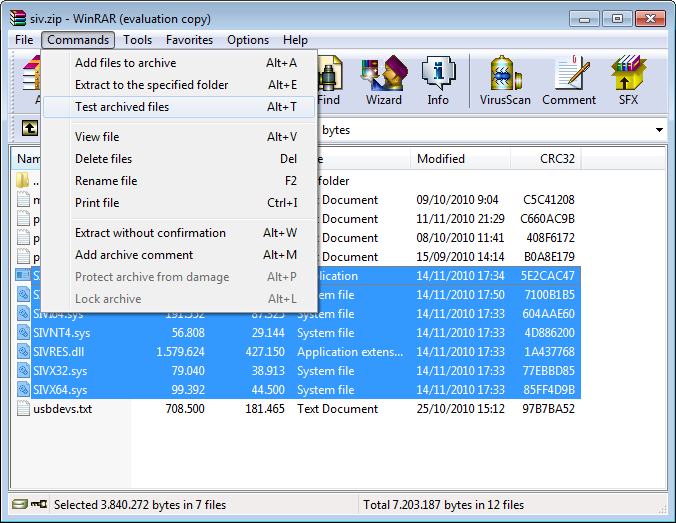
WinRAR
Program designed to help users view compressed files and compress them back
- Category File Compression
- Program license Trial version
- Version 7.00
- Size 2.01 MB
- Works under: Windows 10
- Program available in English
- Program by Rarlab
A whole generation (perhaps two generations) of Windows users have grown up with WinRAR. An untold number of questionable downloads (and uploads) have been processed through this venerable file compression and archive utility since its debut in 1993. It's still going strong today. The only limitation appears to be formats, since WinRAR still only compresses in the Zip and RAR formats.
But honestly, what more are you likely to need?
The WinRAR Way
WinRAR has a full feature set. Password protection and encryption using an AES 256-bit key all come standard, as does a command line giving access to tall the major features available in the GUI. This makes it a favorite of systems admins everywhere as they leverage WinRAR for scripting and automation.
All this goodness is cheap, but not free. You can download WinRAR for a free 40-day full-featured trail. At that point, you'll need to register to continue using it. That's because the RAR format itself is not freeware.
The Formats
Zip is familiar to almost anyone who's touched a computer in the last 30 years or so. It was created in 1989 by engineer Phil Katz. The first implementation was in a utility called PKzip, but zip has since been embraced, extended, adapted, and repackaged by almost all other vendors after being released into public domain. Zip has been evolved and been developed over the decades into something far beyond the original simple file-deflator. The standard now supports strong encryption and other file compression algorithms with even smaller final file sizes. One could do a lot worse than to rely on zip as the compression and archiving file format of choice. It's a grandpa, but a grandpa who still goes to raves.
RAR is almost as old as zip, but isn't quite as open. The compression algorithm has not been released as open-source, and remains restricted from reverse engineering. RAR emerged from Russia shortly after the fall of the Soviet Union, and thus takes name from glorious and heroic father Eugene Roshal (Roshal Archive). The early advantage of RAR was filespanning. A RAR-compresssed archive could span several files, which if combined would have been larger than the limits of the zip format in use at the time. This ability to split an archive over several files of manageable size made RAR popular in the days of slow dial-up internet service. Today, RAR handles archive file sizes of up to 8 exbibytes (9,223,372,036,854,775,807 bytes). File spanning isn't as important with the high-speed internet connections of today.
WinRAR handles both ZIP and RAR with ease. If you're creating archives and compressing even the largest files (8 exbibytes. Wow.), you probably don't need much in the way of other formats.
Pros:
- Intuitive Interface: WinRAR presents a simple face to the world. It's quick and easy to use, and uncluttered with fuzzy visual flourishes, ads, or unnecessary features. It also supports drag-and-drop.
- Command Line: To sysadmins, this is a critical feature. It's far harder to automate GUI-only tools, regardless of what some OS vendors would have you believe. Script around WinRAR to come up with a file archiving or backup app that really works for your own purposes, and set it up to run in the background as you wish.
- Ability to Create Self-Extracting Archives: This is a cool capability wherever it's found. Good to be able to click once, get the files inflated, and get an install going.
- 256-Bit AES Encryption: 256-bit is still pretty strong. How strong? Reports state that a brute-force attack on a 256-bit AES encrypted file would take a supercomputer the size of 10 basketball courts running for the entirety of all existence to go through half the possible combinations. Thus, your diary is likely safe from your little sister's peering eyes, unless she has a computer the size of a planet, or happens to know all your passwords are names of characters from The Flintstones.
- Multi-Format De-compresion Capability: WinRAR can decompress not only RAR and zip, but also their more obscure, hipsters cousins ARJ, TAR, ISO, LZH, UUE, GZ, 7z, ACE, BZ2, JAR, ISO, EXE, zx, and Z.
Cons:
- Compression Formats: It's unlikely you'll really have a need to compress something in the UUE format, and if you do, you probably already have some native utility to do it. But if your daily duties include archiving files in anything other than zip or RAR, WinRAR might not be for you.
- Not Freeware: Because the RAR algorithm is still closed-source commercial software, WinRAR needs to charge something for their product. The prices aren't that expensive, however. And anyway, it's always good to support the efforts of your friendly software development project people.
WinRAR Roars
WinRAR has remained a strong and popular choice for good reasons: It does its work with a minimum of fuss, and it's remained supported and ad-free for close to 25 years. The free 40-day trial period will let you decide if it's the tool for you. Chances are, you'll find many great uses for it once you hear the WinRAR roar.

















